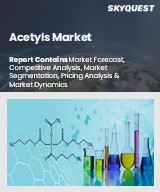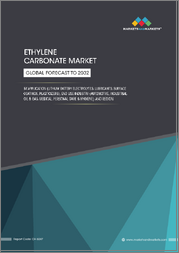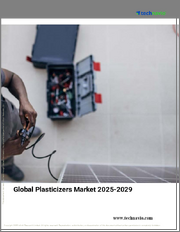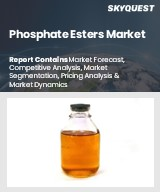
|
시장보고서
상품코드
1715271
세계의 가소제 시장(2025-2035년)Global Plasticizers Market 2025-2035 |
||||||
가소제 시장 : 시장 규모, 점유율, 동향 - 유형별(프탈산에스테르계, 비프탈산에스테르계), 용도별(전선 및 케이블, 바닥재 및 벽재, 필름 및 시트, 코팅 원단, 소비재, 기타) 분석 보고서 : 예측 기간(2025-2035년)
산업 개요
가소제 시장은 2024년에 178억 5,000만 달러로 평가되었고, 예측 기간인 2025-2035년 CAGR 6.3%로 성장할 전망이며, 364억 2,200만 달러에 달할 것으로 예측됩니다. 인프라 정비의 진전, 건설 부문 확대, 바이오 가소제 수요, 연질 폴리염화비닐(PVC) 수요의 증가가 그 요인입니다. The European Plasticizer에 따르면 2023년 세계 소비량은 연간 1,080만 톤에 달했으며, 유럽 가소제 업계의 시장 가치는 2023년 22억 달러에 이르렀습니다. 2030년까지 업계는 신제품에 사용되는 재활용 PVC의 연간 100만 톤 달성을 목표로 하고 있습니다.
시장 역학
바이오 기반 가소제 수요 증가
가소제 업계에서는 환경 문제나 규제상의 요구가 높아지는 가운데, 바이오 기반 대체품으로의 이행이 진행되고 있습니다. 식물성 기름이나 녹말 등의 재생 가능한 원료로 만들어지는 바이오 기반 가소제는 생산자와 소비자가 지속 가능성에 중점을 두게 되면서 주목받는 상품이 되고 있습니다. 이러한 가소제는 석유화학 기반의 화학물질을 감소시킴으로써 보다 지속 가능한 대체품을 제공합니다. 게다가 자동차, 건축, 포장 등의 업계에서는, 환경적으로 지속 가능한 제품에 대한 기운이 높아지고 있어, 바이오 기반 가소제의 사용을 계속 지지하고 있습니다. 이 시프트는, 카본 풋 프린트의 삭감과 순환형 경제의 실현을 향한 세계의 움직임과도 일치하고 있습니다.
전기자동차(EV)용 가소제 급증
전기자동차(EV)의 성장은 특히 자동차 산업에서 새로운 가소제 수요를 가속화하고 있습니다. 자동차 제조업체는 전기자동차와 하이브리드 자동차의 생산에 눈을 돌리고 있으며, 유연성, 내구성, 가혹한 조건 하에서 높은 성능을 제공하는 고급 소재에 대한 요구가 높아지고 있습니다. 가소제는 EV 기능의 핵심이 되는 케이블, 커넥터, 씰 등 많은 부품의 유연성을 높이기 위해 사용되기 때문에 이러한 용도에 필수적입니다. EV로의 전환은 전기자동차 및 하이브리드 자동차의 기술 요구 사항을 충족할 수 있는 보다 효율적이고 고성능인 가소제 수요에 영향을 미치며 가소제 업계의 혁신과 개발을 촉진하고 있습니다.
시장 세분화
- 시장은 유형별로 프탈산에스테르계와 비프탈산에스테르계로 구분됩니다.
- 용도별로 시장은 전선 및 케이블, 바닥재 및 벽재, 필름 및 시트, 피복 섬유, 소비재, 기타(섬유 및 직물)로 구분됩니다.
프탈산에스테르 부문이 최대 점유율로 시장을 선도
프탈산에스테르에 대한 안정적인 수요가 가소제 시장의 개척을 견인하고 있습니다. 프탈산에스테르류는 유연한 폴리머 생산에 널리 사용되어 강인성, 유연성, 내구성을 높입니다. 가소제는 건축, 자동차, 의료 분야에서 사용되며 PVC(폴리염화비닐) 제품의 사용 편의성을 향상시키는 역할을 담당하고 있습니다. 전선, 바닥재, 의료기기의 제조에 있어서 PVC 용도의 증가가 프탈산에스테르 소비량의 증가에 공헌하고 있습니다. 게다가 프탈산에스테르류를 입수하기 쉽고 싼 것도, 플라스틱 산업에서의 폭넓은 이용을 촉진하고 있습니다. 가소제 시장은 더 많은 산업이 프탈산에스테르에 의해 초래되는 이점을 생산에 이용함에 따라 더욱 확대되고 있습니다.
와이어 및 케이블 시장 성장의 주요 부문
가소제 시장은 재료 시스템 내 유연성과 내구성을 높이는 중요한 용도에 있어서 점점 더 기세를 늘리고 있습니다. 의료기기나 고전압 절연 재료에 적용되는 배합 기술이 잠재적으로 성장하고 있기 때문에 기술 혁신의 개발이 진행되고 있습니다. 보다 안전하고 무해한 대체 재료를 도입하는 것을 목적으로 한 정부 정책은 점차 업계의 기대를 형성하고 있습니다. 지속 가능한 폴리머 기술에 대한 투자의 증가는 녹색 가소제를 만들어 냅니다. 전동 모빌리티로의 이행에 따라, 보다 높은 성능 특성을 가지는 신소재의 수요가 높아지고 있습니다. 세계 인프라 프로젝트의 증가로 고강도 가소화 컴파운드의 수요가 높아지고 있습니다. 생분해성 가소제의 획기적인 진보는 학계와 산업계의 연구 제휴를 통해 장려되고 있습니다.
지역별 전망
세계의 가소제 시장은 북미(미국과 캐나다), 유럽(영국, 독일, 프랑스, 이탈리아, 스페인, 러시아, 기타 유럽), 아시아태평양(인도, 중국, 일본, 한국, 호주, 뉴질랜드 및 기타 아시아태평양), 세계 기타 지역(중동 및 아프리카, 중남미)으로 분류됩니다.
아시아태평양의 최종 용도 산업에서 가소제 수요 증가
아시아태평양의 가소제 시장은 주요 국가가 급속히 도시화와 공업화를 진행하고 있는 점에서 성장하고 있습니다. 발전의 주된 원동력의 하나는, 일렉트로닉스, 의료, 건설 용도로 유연한 PVC에 대한 요구가 높아지고 있는 것입니다. 중국과 인도의 생산량 증가에 따라 고성능 가소제의 수요가 증가하고 있습니다. 시장 확대는 인프라 투자를 장려하는 정부 프로그램에 의해 더욱 가속화됩니다. 또한 소비재 부문의 대두로 인해 신발과 가정용품의 수요가 더욱 높아지고 있습니다. 폴리머 연구에 대한 투자와 맞물려 화학 생산의 개발은 신규 제품의 생산을 가능하게 하는 요소가 되고 있습니다.
유럽이 큰 점유율을 차지
유럽은 비프탈산계 가소제와 바이오 가소제의 채용을 증가시키는 엄격한 환경법 때문에 유럽 내 가소제 시장을 견인하는 큰 점유율을 차지하고 있습니다. 시장의 추가 확대는 자동차 산업과 건설 산업의 수요 증가에 의해서도 촉진되고 있습니다. 플라스틱 제품에 지속 가능성과 재활용성이 요구됨에 따라 생산자는 친환경 대체 제품을 개발하게 되었습니다. 폴리머 가공에 있어서 기술의 진보는, 몇가지 용도에 있어서 가소제의 기능성을 향상시키고 있습니다. 자동차 제조업체가 견고하고 가벼운 소재로 전환함에 따라 수요도 개발되고 있습니다. 포장 분야의 확대도 전자상거래의 확대나 식품의 안전성에 대한 우려에서 기인하는 중요한 요인이 되고 있습니다.
최근 동향
- 2024년 10월-에보닉 옥세노는 INA 기반의 가소제인 에라툴 CH(DINCH)와 에라툴 DINCD의 생산 능력을 대폭 확대했습니다. 이러한 제품은 에보닉 옥세노 고객과의 새로운 표준 가소제로서의 지위를 확립했습니다. 유럽 시장에 있어서 이소노나놀(INA) 베이스의 가소제의 신뢰할 수 있는 확실한 공급을 확보했습니다.
- 2023년 6월-KLJ그룹은 1억 4,500만 달러를 투자해, 가소제 무수프탈산 제조 장치(BIS인가)를 가동시켰습니다. KLJ 그룹의 제품 기반 확대와 시장의 확대되는 수요에 대한 대응은 이 통합 플랜트 설비가 증명하고 있습니다.
목차
제1장 보고서 요약
- 업계의 현황 분석 및 성장 잠재력의 전망
- 세계의 가소제 시장 판매 분석 : 유형별 및 용도별
- 가소제 시장 상위국의 판매 실적
- 조사 방법
- 1차 조사 접근
- 2차 조사 접근법
- 시장 현황
제2장 시장 개요 및 인사이트
- 조사 범위
- 애널리스트의 인사이트 및 현재 시장 동향
- 가소제 업계의 주요 동향
- 시장 추천 사항
- 가소제 시장의 Porter's Five Forces 분석
- 경쟁 기업간 경쟁 관계
- 신규 참가업체의 위협
- 공급기업의 협상력
- 구매자의 협상력
- 대체품의 위협
제3장 시장의 결정 요인
- 시장 성장 촉진요인
- 세계의 가소제 시장 촉진요인 : 영향 분석
- 시장의 페인 포인트와 과제
- 세계의 가소제 시장 억제요인 : 영향 분석
- 시장 기회
제4장 경쟁 구도
- 경쟁 대시보드 : 가소제 시장의 매출 및 제조업체별 점유율
- 가소제의 제품 비교 분석
- 주요 기업 순위 매트릭스
- 주요 기업 분석
- BASF SE
- Eastman Chemical Co.
- Evonik Oxeno GmbH & Co.
- Exxon Mobil Corp.
- LG Chem
- 주요 기업의 주요 성공 전략
- 합병 및 인수
- 제품 출시
- 파트너십 및 협업
제5장 세계의 가소제 시장 매출 분석 : 유형별
- 프탈산염
- 비프탈산염
제6장 세계의 가소제 시장 매출 분석 : 용도별
- 와이어 및 케이블
- 바닥재 및 벽재
- 필름 및 시트
- 코팅 원단
- 소비재
- 기타(섬유 제품)
제7장 지역 분석
- 북미의 가소제 시장 매출 분석 : 유형별, 용도별 및 국가별
- 북미의 거시경제 요인
- 미국
- 캐나다
- 유럽의 가소제 시장 매출 분석 : 유형별, 용도별 및 국가별
- 유럽의 거시경제 요인
- 영국
- 독일
- 이탈리아
- 스페인
- 프랑스
- 러시아
- 기타 유럽
- 아시아태평양의 가소제 시장 매출 분석 : 유형별, 용도별 및 국가별
- 아시아태평양의 거시 경제 요인
- 중국
- 일본
- 한국
- 인도
- 호주 및 뉴질랜드
- ASEAN 국가(태국, 인도네시아, 베트남, 싱가포르 등)
- 기타 아시아태평양
- 세계 기타 지역의 가소제 시장 매출 분석 : 유형별, 용도별 및 국가별
- 세계 기타 지역의 거시 경제 요인
- 라틴아메리카
- 중동 및 아프리카
제8장 기업 프로파일
- ACS Technical Products
- Avient Corp.
- Baerlocher GmbH
- BASF SE
- Cargill, Inc.
- DIC Corp.
- Eastman Chemical Co.
- Emery Oleochemicals Group
- Evonik Oxeno GmbH & Co.
- Exxon Mobil Corp.
- Ferro Corp.
- Goldstab Organics PVT. LTD.
- INEOS Group
- Kao Corp.
- KLJ Group
- LANXESS
- LG Chem Ltd.
- Matrica SpA
- Perstorp Holding AB
- Polynt SpA
- Roquette Freres
- SABIC
- The Solvay Group
- The Chemical Co.(ChemFlexx)
- Velsicol Chemical LLC
Plasticizers Market Size, Share & Trends Analysis Report by Type (Phthalate and Non-phthalate), and Application (Wires & Cables, Floorings & Wall Coverings, Films & Sheets, Coated Fabrics, Consumer Goods and Others) Forecast Period (2025-2035)
Industry Overview
Plasticizers market was valued at $17,850 million in 2024 and is projected to reach $36,422 million in 2035, growing at a CAGR of 6.3% during the forecast period (2025-2035) driven by the growing infrastructure development, expanding construction sector, demand for bio-plasticizers, and increase in demand for flexible polyvinyl chloride (PVC). According to the European Plasticizer, in 2023, yearly the global consumption of plasticizers reached 10.8 million tons. The European plasticizer industry's market value is $2.2 billion in 2023. By 2030, the industry aims to achieve 1 million tons per year of recycled PVC used in new products.
Market Dynamics
Growing Demand for Bio-based Plasticizers
The plasticizer industry is witnessing a move towards bio-based alternatives with mounting environmental issues and regulatory demands. Bio-based plasticizers from renewable raw materials such as plant oils or starch are hot commodities as producers and consumers redirect their focus on sustainability. They provide a more sustainable alternative in the form of lower petrochemical-based chemicals. In addition, the surge of momentum on environmentally sustainable products in industries including automotive, construction, and packaging continues to push the use of bio-based plasticizers. The shift is also in line with the global push toward reducing carbon footprints and enabling circular economies.
Surge in Plasticizers for Electric Vehicle (EV) Applications
The growth in electric vehicles (EVs) is accelerating new plasticizer demand, especially within the automotive industry. Vehicle manufacturers have turned their attention to producing electric and hybrid cars, and the need for premium materials that offer flexibility, durability, and high performance in harsh conditions has grown. Plasticizers are essential in such applications, as they are used to enhance the flexibility of many components, such as cables, connectors, and seals, that are key to EV functioning. The shift towards EVs is influencing the demand for more efficient and high-performance plasticizers that can fulfill electric and hybrid vehicle technical requirements, encouraging innovations and development in the plasticizer industry.
Market Segmentation
- Based on the type, the market is segmented into phthalate and non-phthalate.
- Based on the application, the market is segmented into wires & cables, floorings & wall coverings, films & sheets, coated fabrics, consumer goods, and others (textiles & fabrics).
Phthalate Segment to Lead the Market with the Largest Share
The consistent requirement for phthalates is driving the development of the plasticizer market. Phthalates are widely used in the production of flexible polymers to increase their toughness, pliability, and durability. The plasticizers are used in the building, automobile, and medical sectors and are held accountable for improving the usability of PVC (polyvinyl chloride) products. The increasing uses of PVC in the production of wires, flooring, and medical equipment have helped increase phthalate consumption. Moreover, the availability and low cost of phthalates also facilitate their extensive utilization in the plastics industry. The plasticizer market is expanding even further as more industries come to depend on the advantages provided by phthalates in their production.
Wires & Cables: A Key Segment in Market Growth
The plasticizer market is increasingly gaining momentum in its critical usage in enhancing flexibility and durability within the material system. The potential growth in formulating techniques applied to medical equipment and high-voltage insulation materials makes for innovation development. Government policy aimed at incorporating safer and more nontoxic alternatives is gradually shaping industry expectations. Increasing investment in sustainable polymer technologies produces green plasticizers. New materials with higher performance characteristics are in high demand owing to the move towards electric mobility. The increasing scope of infrastructure projects globally is creating more demand for high-strength plasticized compounds. Breakthroughs in biodegradable plasticizers are being encouraged through research partnerships between academia and industry.
Regional Outlook
The global plasticizers market is further divided by geography, including North America (the US and Canada), Europe (the UK, Germany, France, Italy, Spain, Russia, and the Rest of Europe), Asia-Pacific (India, China, Japan, South Korea, Australia and New Zealand, ASEAN Countries, and the Rest of Asia-Pacific), and the Rest of the World (the Middle East & Africa, and Latin America).
Growing Demand for Plasticizers in End-Use Industries in Asia-Pacific
Asia-Pacific plasticizer market is growing with major nations rapidly undergoing urbanization and industrialization. One of the major drivers of development is the increased need for flexible PVC in electronics, medical, and construction applications. With rising production in China and India, there is a rise in demand for high-performance plasticizers. The market expansion is accelerated further by government programs encouraging infrastructural investments. Moreover, demand for shoes and house commodities is triggered further by an emerging consumer goods sector. Developing chemical production coupled with investment in polymer research serves as an enabling element in producing novel products.
Europe Region Dominates the Market with Major Share
Europe holds a significant share owing to strict environmental laws that increase the adoption of non-phthalate and bio-based plasticizers driving the plasticizer market within Europe. A further expansion of the market is also facilitated by the increasing demand in the automotive and construction industries. The increasing use of sustainability and recyclability in plastic products triggers the producers to develop environmentally friendly alternative products. The technological advancements in polymer processing improve plasticizer's functionality in several applications. Demand is also developed owing to car manufacturers switching to robust and lightweight materials. Packaging sector expansion also constitutes a significant demand factor owing to the growing e-commerce and concern for food safety
Market Players Outlook
The major companies operating in the global plasticizers market include BASF SE, Eastman Chemical Co., Evonik Oxeno GmbH & Co., Exxon Mobil Corp., and LG Chem, among others. Market players are leveraging partnerships, collaborations, mergers and acquisition strategies for business expansion and innovative product development to maintain their market positioning.
Recent Developments
- In October 2024, Evonik Oxeno is significantly expanding its production capacities for the INA-based plasticizers, ELATUR CH (DINCH) and ELATUR DINCD. These products established themselves as new standard plasticizers with Evonik Oxeno customers. Ensuring a reliable and secure supply of isononanol (INA)-based plasticizers for the European market.
- In June 2023, KLJ Group invested $145 million and commissioned a Plasticizers & Phthalic Anhydride manufacturing unit (BIS approved). KLJ Group's commitment to increasing its product base and meeting the growing demands of the market can be attested to by this integrated plant facility.
The Report Covers:
- Market value data analysis of 2024 and forecast to 2035.
- Annualized market revenues ($ million) for each market segment.
- Country-wise analysis of major geographical regions.
- Key companies operating in the global plasticizers market. Based on the availability of data, information related to new products, and relevant news is also available in the report.
- Analysis of business strategies by identifying the key market segments positioned for strong growth in the future.
- Analysis of market-entry and market expansion strategies.
- Competitive strategies by identifying 'who-stands-where' in the market.
Table of Contents
1. Report Summary
- Current Industry Analysis and Growth Potential Outlook
- Global Plasticizers Market Sales Analysis - Type| Application ($ Million)
- Plasticizers Market Sales Performance of Top Countries
- 1.1. Research Methodology
- Primary Research Approach
- Secondary Research Approach
- 1.2. Market Snapshot
2. Market Overview and Insights
- 2.1. Scope of the Study
- 2.2. Analyst Insight & Current Market Trends
- 2.2.1. Key Plasticizers Industry Trends
- 2.2.2. Market Recommendations
- 2.3. Porter's Five Forces Analysis for the Plasticizers Market
- 2.3.1. Competitive Rivalry
- 2.3.2. Threat of New Entrants
- 2.3.3. Bargaining Power of Suppliers
- 2.3.4. Bargaining Power of Buyers
- 2.3.5. Threat of Substitutes
3. Market Determinants
- 3.1. Market Drivers
- 3.1.1. Drivers For Global Plasticizers Market: Impact Analysis
- 3.2. Market Pain Points and Challenges
- 3.2.1. Restraints For Global Plasticizers Market: Impact Analysis
- 3.3. Market Opportunities
4. Competitive Landscape
- 4.1. Competitive Dashboard - Plasticizers Market Revenue and Share by Manufacturers
- Plasticizers Product Comparison Analysis
- Top Market Player Ranking Matrix
- 4.2. Key Company Analysis
- 4.2.1. BASF SE
- 4.2.1.1. Overview
- 4.2.1.2. Product Portfolio
- 4.2.1.3. Financial Analysis (Subject to Data Availability)
- 4.2.1.4. SWOT Analysis
- 4.2.1.5. Business Strategy
- 4.2.2. Eastman Chemical Co.
- 4.2.2.1. Overview
- 4.2.2.2. Product Portfolio
- 4.2.2.3. Financial Analysis (Subject to Data Availability)
- 4.2.2.4. SWOT Analysis
- 4.2.2.5. Business Strategy
- 4.2.3. Evonik Oxeno GmbH & Co.
- 4.2.3.1. Overview
- 4.2.3.2. Product Portfolio
- 4.2.3.3. Financial Analysis (Subject to Data Availability)
- 4.2.3.4. SWOT Analysis
- 4.2.3.5. Business Strategy
- 4.2.4. Exxon Mobil Corp.
- 4.2.4.1. Overview
- 4.2.4.2. Product Portfolio
- 4.2.4.3. Financial Analysis (Subject to Data Availability)
- 4.2.4.4. SWOT Analysis
- 4.2.4.5. Business Strategy
- 4.2.5. LG Chem
- 4.2.5.1. Overview
- 4.2.5.2. Product Portfolio
- 4.2.5.3. Financial Analysis (Subject to Data Availability)
- 4.2.5.4. SWOT Analysis
- 4.2.5.5. Business Strategy
- 4.2.1. BASF SE
- 4.3. Top Winning Strategies by Market Players
- 4.3.1. Merger and Acquisition
- 4.3.2. Product Launch
- 4.3.3. Partnership And Collaboration
5. Global Plasticizers Market Sales Analysis by Type ($ Million)
- 5.1. Phthalate
- 5.2. Non-phthalate
6. Global Plasticizers Market Sales Analysis by Application ($ Million)
- 6.1. Wires & Cables
- 6.2. Floorings & Wall Coverings
- 6.3. Films & Sheets
- 6.4. Coated Fabrics
- 6.5. Consumer Goods
- 6.6. Others (Textiles & Fabrics)
7. Regional Analysis
- 7.1. North American Plasticizers Market Sales Analysis - Type| Application| Country ($ Million)
- Macroeconomic Factors for North America
- 7.1.1. United States
- 7.1.2. Canada
- 7.2. European Plasticizers Market Sales Analysis - Type| Application| Country ($ Million)
- Macroeconomic Factors for Europe
- 7.2.1. UK
- 7.2.2. Germany
- 7.2.3. Italy
- 7.2.4. Spain
- 7.2.5. France
- 7.2.6. Russia
- 7.2.7. Rest of Europe
- 7.3. Asia-Pacific Plasticizers Market Sales Analysis - Type| Application| Country ($ Million)
- Macroeconomic Factors for Asia-Pacific
- 7.3.1. China
- 7.3.2. Japan
- 7.3.3. South Korea
- 7.3.4. India
- 7.3.5. Australia & New Zealand
- 7.3.6. ASEAN Countries (Thailand, Indonesia, Vietnam, Singapore, And Other)
- 7.3.7. Rest of Asia-Pacific
- 7.4. Rest of the World Plasticizers Market Sales Analysis - Type| Application| Country ($ Million)
- Macroeconomic Factors for the Rest of the World
- 7.4.1. Latin America
- 7.4.2. Middle East and Africa
8. Company Profiles
- 8.1. ACS Technical Products
- 8.1.1. Quick Facts
- 8.1.2. Company Overview
- 8.1.3. Product Portfolio
- 8.1.4. Business Strategies
- 8.2. Avient Corp.
- 8.2.1. Quick Facts
- 8.2.2. Company Overview
- 8.2.3. Product Portfolio
- 8.2.4. Business Strategies
- 8.3. Baerlocher GmbH
- 8.3.1. Quick Facts
- 8.3.2. Company Overview
- 8.3.3. Product Portfolio
- 8.3.4. Business Strategies
- 8.4. BASF SE
- 8.4.1. Quick Facts
- 8.4.2. Company Overview
- 8.4.3. Product Portfolio
- 8.4.4. Business Strategies
- 8.5. Cargill, Inc.
- 8.5.1. Quick Facts
- 8.5.2. Company Overview
- 8.5.3. Product Portfolio
- 8.5.4. Business Strategies
- 8.6. DIC Corp.
- 8.6.1. Quick Facts
- 8.6.2. Company Overview
- 8.6.3. Product Portfolio
- 8.6.4. Business Strategies
- 8.7. Eastman Chemical Co.
- 8.7.1. Quick Facts
- 8.7.2. Company Overview
- 8.7.3. Product Portfolio
- 8.7.4. Business Strategies
- 8.8. Emery Oleochemicals Group
- 8.8.1. Quick Facts
- 8.8.2. Company Overview
- 8.8.3. Product Portfolio
- 8.8.4. Business Strategies
- 8.9. Evonik Oxeno GmbH & Co.
- 8.9.1. Quick Facts
- 8.9.2. Company Overview
- 8.9.3. Product Portfolio
- 8.9.4. Business Strategies
- 8.10. Exxon Mobil Corp.
- 8.10.1. Quick Facts
- 8.10.2. Company Overview
- 8.10.3. Product Portfolio
- 8.10.4. Business Strategies
- 8.11. Ferro Corp.
- 8.11.1. Quick Facts
- 8.11.2. Company Overview
- 8.11.3. Product Portfolio
- 8.11.4. Business Strategies
- 8.12. Goldstab Organics PVT. LTD.
- 8.12.1. Quick Facts
- 8.12.2. Company Overview
- 8.12.3. Product Portfolio
- 8.12.4. Business Strategies
- 8.13. INEOS Group
- 8.13.1. Quick Facts
- 8.13.2. Company Overview
- 8.13.3. Product Portfolio
- 8.13.4. Business Strategies
- 8.14. Kao Corp.
- 8.14.1. Quick Facts
- 8.14.2. Company Overview
- 8.14.3. Product Portfolio
- 8.14.4. Business Strategies
- 8.15. KLJ Group
- 8.15.1. Quick Facts
- 8.15.2. Company Overview
- 8.15.3. Product Portfolio
- 8.15.4. Business Strategies
- 8.16. LANXESS
- 8.16.1. Quick Facts
- 8.16.2. Company Overview
- 8.16.3. Product Portfolio
- 8.16.4. Business Strategies
- 8.17. LG Chem Ltd.
- 8.17.1. Quick Facts
- 8.17.2. Company Overview
- 8.17.3. Product Portfolio
- 8.17.4. Business Strategies
- 8.18. Matrica S.p.A.
- 8.18.1. Quick Facts
- 8.18.2. Company Overview
- 8.18.3. Product Portfolio
- 8.18.4. Business Strategies
- 8.19. Perstorp Holding AB
- 8.19.1. Quick Facts
- 8.19.2. Company Overview
- 8.19.3. Product Portfolio
- 8.19.4. Business Strategies
- 8.20. Polynt S.p.A.
- 8.20.1. Quick Facts
- 8.20.2. Company Overview
- 8.20.3. Product Portfolio
- 8.20.4. Business Strategies
- 8.21. Roquette Freres
- 8.21.1. Quick Facts
- 8.21.2. Company Overview
- 8.21.3. Product Portfolio
- 8.21.4. Business Strategies
- 8.22. SABIC
- 8.22.1. Quick Facts
- 8.22.2. Company Overview
- 8.22.3. Product Portfolio
- 8.22.4. Business Strategies
- 8.23. The Solvay Group
- 8.23.1. Quick Facts
- 8.23.2. Company Overview
- 8.23.3. Product Portfolio
- 8.23.4. Business Strategies
- 8.24. The Chemical Co. (ChemFlexx)
- 8.24.1. Quick Facts
- 8.24.2. Company Overview
- 8.24.3. Product Portfolio
- 8.24.4. Business Strategies
- 8.25. Velsicol Chemical LLC
- 8.25.1. Quick Facts
- 8.25.2. Company Overview
- 8.25.3. Product Portfolio
- 8.25.4. Business Strategies



















